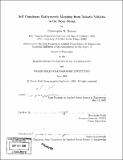Self consistent bathymetric mapping from robotic vehicles in the deep ocean
Author(s)
Roman, Christopher N
DownloadFull printable version (21.56Mb)
Other Contributors
Woods Hole Oceanographic Institution.
Advisor
Hanumant Singh.
Terms of use
Metadata
Show full item recordAbstract
Obtaining accurate and repeatable navigation for robotic vehicles in the deep ocean is difficult and consequently a limiting factor when constructing vehicle-based bathymetric maps. This thesis presents a methodology to produce self-consistent maps and simultaneously improve vehicle position estimation by exploiting accurate local navigation and utilizing terrain relative Measurements. It is common for errors in the vehicle position estimate to far exceed the errors associated with the acoustic range sensor. This disparity creates inconsistency when an area is imaged multiple times and causes artifacts that distort map integrity. Our technique utilizes small terrain "sub-maps" that can be pairwise registered and used to additionally constrain the vehicle position estimates in accordance with actual bottom topography. A delayed state Kalman filter is used to incorporate these sub-map registrations as relative position measurements between previously visited vehicle locations. The archiving of previous positions in a filter state vector allows for continual adjustment of the sub-map locations. The terrain registration is accomplished using a two dimensional correlation and a six degree of freedom point cloud alignment method tailored for bathymetric data. (cont.) The complete bathymetric map is then created from the union of all sub-maps that have been aligned in a consistent manner. Experimental results from the fully automated processing of a multibeamn survey over the TAG hydrothermal structure at the Mid-Atlantic ridge are presented to validate the proposed method.
Description
Thesis (Ph. D.)--Joint Program in Applied Ocean Science and Engineering (Massachusetts Institute of Technology, Dept. of Ocean Engineering; and the Woods Hole Oceanographic Institution), 2005. Bibliography: p. 119-129.
Date issued
2005Department
Joint Program in Applied Ocean Physics and Engineering; Woods Hole Oceanographic Institution; Massachusetts Institute of Technology. Department of Ocean EngineeringPublisher
Massachusetts Institute of Technology
Keywords
/Woods Hole Oceanographic Institution. Joint Program in Applied Ocean Science and Engineering., Ocean Engineering., Woods Hole Oceanographic Institution.